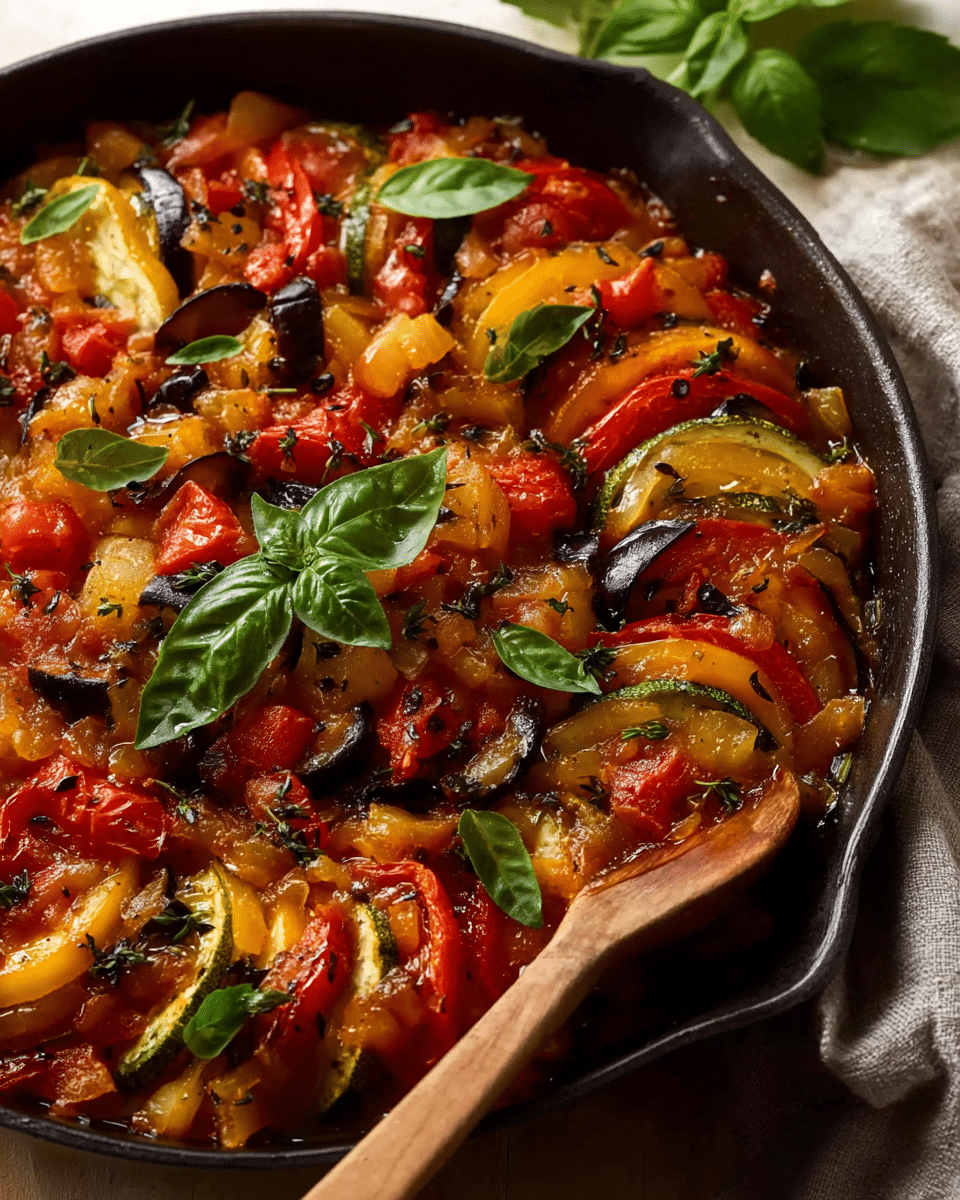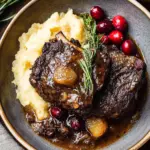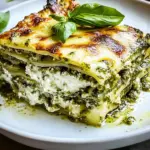Ratatouille is a stunning vegetable medley that celebrates the freshness of summer. It’s a colorful dish, with beautifully arranged slices of eggplant, zucchini, bell pepper, and tomatoes, all drizzled with olive oil and seasoned to perfection. The vegetables bake to a tender, flavorful texture that’s impossible to resist.
Perfect as a side dish or a main for a light dinner, ratatouille is incredibly versatile. You can serve it on its own, paired with rice or crusty bread, or even over a bed of quinoa. This dish will have you savoring the vibrant flavors of summer in every bite, while keeping things fresh and wholesome.
Full recipe:
Ingredients:
-
2 tablespoons olive oil
-
1 large onion, thinly sliced
-
1 bell pepper, thinly sliced
-
1 zucchini, thinly sliced
-
1 eggplant, thinly sliced
-
2 tomatoes, thinly sliced
-
2 garlic cloves, minced
-
1 teaspoon dried thyme
-
1 teaspoon dried oregano
-
Salt and pepper to taste
-
Fresh basil, for garnish
Directions:
-
Preheat oven to 375°F (190°C).
-
In a large skillet, heat olive oil over medium heat. Add the onion and bell pepper and sauté for 5-7 minutes, until softened.
-
Add the zucchini, eggplant, tomatoes, and garlic to the skillet. Stir in thyme, oregano, salt, and pepper. Cook for 5-10 minutes until vegetables are tender.
-
Transfer the vegetables into a baking dish and arrange them in layers, alternating the vegetables in a spiral pattern.
-
Drizzle with olive oil, sprinkle with additional thyme and oregano, and season with salt and pepper.
-
Cover the dish with foil and bake for 30 minutes. Then remove the foil and bake for another 10-15 minutes until the vegetables are fully cooked and slightly browned.
-
Garnish with fresh basil before serving.
Prep Time: 15 minutes | Cooking Time: 45 minutes | Total Time: 1 hour Kcal: 140 kcal | Servings: 4 servings
The Origins and History of Ratatouille
Ratatouille is a quintessential Provençal dish, and its origins are closely tied to the region’s rustic farming traditions. The name “ratatouille” comes from the French word “touiller,” which means “to stir” or “to toss.” Traditionally, the dish was made with a variety of vegetables that were abundant in the region, such as eggplant, zucchini, tomatoes, and bell peppers. Ratatouille was originally considered a peasant dish because it utilized inexpensive and locally grown produce. It was a way to make the most out of the summer harvest, often cooked in a simple, one-pot method.
Historically, ratatouille was served as a side dish, complementing meats, breads, and cheeses. Over time, however, it evolved into a main dish in its own right, especially in the warmer months when vegetables were plentiful. The dish’s popularity skyrocketed in the 20th century, not only due to its great taste but also because of its health benefits and versatility.
Though it is now enjoyed around the world, ratatouille remains a deeply cultural and traditional meal in Provence, often prepared for family gatherings and special occasions. The dish also gained international fame after the 2007 Pixar movie Ratatouille, where the main character, a rat named Remy, uses the dish to win over the hearts of gourmet chefs. The movie’s portrayal helped to solidify ratatouille as a symbol of rustic French cuisine and elevated its profile worldwide.
Health Benefits of Ratatouille
One of the standout features of ratatouille is its health benefits. The dish is composed primarily of vegetables, which are rich in essential vitamins, minerals, and antioxidants. Here are some of the key health benefits of this delicious stew:
-
Packed with Nutrients: The vegetables used in ratatouille, such as eggplant, zucchini, and tomatoes, are high in dietary fiber, which is important for digestive health. They also contain a range of vitamins, including vitamin C, vitamin A, and folate. These nutrients play a critical role in boosting the immune system, improving skin health, and reducing the risk of chronic diseases.
-
Antioxidants: Tomatoes, one of the key ingredients in ratatouille, are a rich source of lycopene, an antioxidant that has been linked to reduced risks of heart disease and certain types of cancer. Eggplants contain nasunin, a powerful antioxidant that protects the brain’s cell membranes.
-
Low in Calories: Ratatouille is a great option for those looking to maintain or lose weight. The dish is low in calories but high in flavor, making it a filling yet light choice for a meal. The abundance of vegetables provides a satisfying meal without overloading on fats or unhealthy ingredients.
-
High in Fiber: The vegetables in ratatouille, particularly zucchini and eggplant, are high in fiber, which promotes digestive health, supports heart health, and helps regulate blood sugar levels. Fiber also aids in satiety, making the dish a great option for those seeking to feel fuller for longer.
-
Plant-Based and Vegan-Friendly: As a vegetable-based dish, ratatouille is naturally vegan and can be enjoyed by those following a plant-based diet. It’s also suitable for various dietary restrictions, such as gluten-free or dairy-free diets, making it an inclusive meal option for different dietary preferences.
Serving Suggestions for Ratatouille
Ratatouille can be enjoyed in a variety of ways, whether as a main course or a side dish. Here are a few ideas to help you serve it in a variety of settings:
-
As a Side Dish: Ratatouille pairs wonderfully with grilled meats, such as lamb, chicken, or beef, providing a fresh and healthy contrast to rich and savory flavors. You can also serve it alongside crusty French bread to soak up the flavorful sauce.
-
With Rice or Quinoa: If you’re looking to make ratatouille the centerpiece of a meal, serving it over a bed of rice or quinoa is an excellent option. The grains absorb the juices from the vegetables and provide a satisfying base for the dish.
-
With Pasta: Another great option is to serve ratatouille with pasta, especially when you want to make a heartier meal. The tender vegetables in the ratatouille blend beautifully with the pasta, creating a balanced and flavorful dish.
-
On Its Own: Ratatouille can also be served on its own, making for a light yet fulfilling meal. For a vegetarian or vegan option, you can serve it with a dollop of hummus or a sprinkle of nutritional yeast for an extra boost of flavor.
-
As a Topping: Ratatouille also makes a great topping for other dishes. For example, you can spoon it over baked potatoes, roasted meats, or grilled vegetables for added flavor and texture. It’s a versatile topping that can enhance a wide variety of meals.
-
With Cheese: For those who enjoy dairy, ratatouille can be paired with grated Parmesan or crumbled feta cheese. The saltiness and creaminess of the cheese complement the savory vegetables, creating a rich, comforting dish.
Variations of Ratatouille
While the classic ratatouille recipe calls for a set list of vegetables, there are plenty of ways to personalize the dish. Here are a few variations you can try:
-
Add Herbs and Spices: The traditional seasoning for ratatouille includes thyme, rosemary, and basil. However, you can experiment with other herbs like oregano, tarragon, or even a pinch of saffron to create unique flavor profiles. A touch of smoked paprika can also add depth to the dish.
-
Add Protein: If you’d like to make ratatouille more filling, you can add a protein source such as chickpeas, lentils, or tofu. This turns the dish into a complete, satisfying meal that can be enjoyed by everyone, regardless of dietary preferences.
-
Roasted Ratatouille: While the traditional ratatouille is often simmered on the stovetop or baked, you can also roast the vegetables separately to intensify their flavors. Roasting the vegetables brings out their natural sweetness and adds a smoky depth to the dish.
-
Serve with Pesto: For a burst of fresh flavor, serve ratatouille with a drizzle of homemade or store-bought pesto. The vibrant green sauce adds a rich herby note that complements the dish’s vegetables.
Conclusion
Ratatouille is much more than just a vegetable stew; it is a celebration of summer’s bounty. With its vibrant colors and rich flavors, this dish brings together the essence of French provincial cooking in a way that is both simple and sophisticated. Whether you serve it as a side dish, a main course, or as part of a larger meal, ratatouille is versatile, healthy, and delicious. Its history, health benefits, and wide array of serving options make it a perfect dish to add to any meal plan.
This dish is not only a wonderful way to enjoy fresh vegetables but also a testament to the beauty of seasonal cooking. With its humble origins and global appeal, ratatouille continues to captivate food lovers worldwide. So next time you’re looking for a comforting, healthy, and flavorful meal, don’t hesitate to whip up a batch of this classic French dish—it’s sure to become a staple in your kitchen.






